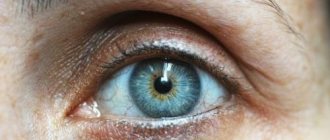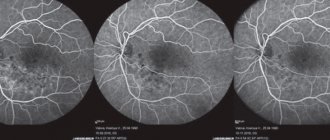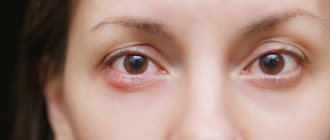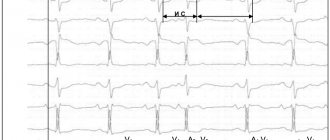Possible causes of red eyes
- Diseases of the conjunctiva:
- conjunctivitis (infectious conjunctivitis caused by bacteria, viruses, chlamydia; non-infectious conjunctivitis - allergic conjunctivitis, dry eye syndrome, toxic effects of drugs on the conjunctiva, conjunctivitis in systemic diseases);
- conjunctival tumors;
- subconjunctival hemorrhage.
2. Diseases of the cornea:
- infectious keratitis (caused by bacteria, viruses, chlamydia, fungi, protozoa);
- non-infectious keratitis (paralytic, associated with non-closure of the palpebral fissure, with systemic diseases, with allergic diseases);
- keratopathy;
- syndrome of recurrent epithelial defects.
3. Uveal diseases:
- anterior uveitis (inflammation of the iris and/or ciliary body);
- bacterial endophthalmitis.
4. Attack of angle-closure glaucoma.
5. Injuries to the eyeball (eyelids, orbits, conjunctiva, cornea, sclera).
6. Diseases of the eyelids:
- abnormal eyelash growth;
- eversion of eyelids;
- inflammation of the edges of the eyelids - blepharitis;
- barley.
7. Diseases of the sclera:
- episcleritis;
- scleritis
8. Orbital diseases:
- thyroid orbitopathy;
- inflammatory diseases;
- orbital tumors;
9. Cluster headaches.
The sudden appearance of redness indicates the beginning of a painful process. The following symptoms accompanying eye redness require urgent intervention:
- sensitivity to light - photophobia;
- the appearance of rainbow circles around the lamps;
- sudden appearance of double vision;
- accompanying severe headache.
What kind of drops are there?
Drops for eye redness are an ophthalmic solution, the composition of which is selected in such a way as to solve problems with blood vessels caused by specific reasons. Therefore, all funds are divided into several groups.
Gilan drops imitate natural tears
Moisturizing compositions are necessary for constant visual work, especially with high load, as well as when wearing contact lenses. As mentioned above, they imitate natural tears and moisturize the surface of the eyes, helping to get rid of burning and itching, reducing the negative impact of external factors. Moisturizing drops can be used as needed, daily, up to 5-6 times a day.
Drops that constrict blood vessels and help relieve swelling are also recommended for increased visual stress. Thanks to them, the small capillaries located in the tunica albuginea narrow, and the redness disappears, and the eye looks white again. Vasoconstrictor drops can be used no more than 1-2 times a week. Regular use of such drugs can lead to undesirable consequences, for example, disruption of the nutrition of the eye structures and increased intraocular pressure. In addition, drugs in this group are addictive.
Preparations "Systane Ultra" and "Systane Ultra Plus" allow you to quickly relieve redness
An ophthalmologist prescribes antihistamine and anti-inflammatory solutions if the cause of eye redness is an allergic reaction. They help cope with vasodilation, as well as itching and increased tearing. In severe cases of allergies, hormonal solutions help.
Often the cause of red eyes is an infection. In this case, it is necessary to use antibacterial drugs.
Artelak Splash eye drops effectively combat dry eyes
For ARVI, influenza and herpes virus, antiviral drops can be prescribed. Vitamin complexes are used to maintain eye health. These are general strengthening drugs that can be used for preventive purposes. But they won't help if your eyes are already red.
The following medications are used to combat eye redness:
- “Systein Ultra”, “Gilan” and “Artelak Splash” are drops that imitate natural tear fluid. This type of medication is prescribed in cases where redness is caused by dry eyes;
- “Okumetil” and Innoxa are drops that have a vasoconstrictor and anti-edematous effect. Recommended in cases where redness is caused by high visual stress;
- "Dexa-Gentamicin" is an antibiotic that is prescribed for infections of the anterior segment of the eye, allergies accompanied by bacterial infection, and for preventive purposes after operations on the visual organ;
- "Floxal" - antimicrobial medicinal drops that are used for infectious and inflammatory diseases of the eye.
Any medications should be used only as prescribed by a specialist. Self-medication can only worsen existing problems!
Types of redness:
- Superficial - the greatest intensity of redness is visible in the peripheral part of the conjunctival sac; this type of redness indicates dilation of the conjunctival vessels, external inflammation; usually requires consultation with a doctor.
- Deep (pericorneal) - a blue-red border around the cornea, this means that the vessels in the sclera are dilated, inflammation inside the eye; appears in diseases of the cornea and iris; Urgent consultation with a doctor is required.
- Mixed - there is dilation of the vessels of the conjunctiva and sclera around the cornea; immediate contact with an ophthalmologist is required.
It is worth considering whether any of the symptoms predominate:
- discomfort and discharge from the eye - most often indicate an infection;
- itchy skin - indicates the most common allergic diseases;
- increased burning sensation during the day - most often this indicates dry eye syndrome;
- redness, swelling of the eyelids - this most often indicates inflammation of the eyelids.
A combination of symptoms can help determine the cause and provide effective treatment.
Why do my eyes turn red?
Red eyes usually mean redness of the sclera, the white membrane of the eye. The sclera contains a significant number of capillaries - the smallest blood vessels. Usually they are invisible, but under the influence of a number of circumstances, the blood vessels of the sclera can expand, the walls of the vessels stretch as they expand, and then we see them, or rather, we see the blood filling the vessels. The blood is red, causing the eyes to appear red.
In most cases, dilation of scleral vessels is caused by a sharp increase in blood circulation. This is how the body responds to a fairly wide range of problems. Blood is an internal transport through which nutrients are delivered and toxins are removed. Blood flow helps increase local immune defense and accelerates healing. In many cases, the redness of the eyes goes away quite quickly; this means that the blood supply to the sclera has returned to normal. If the redness persists for a long time, then, obviously, the problem that caused it is quite serious.
People need urgent assistance on the same day:
- after mechanical injuries (foreign body, blow, abrasion);
- for chemical burns of the eyes;
- with a significant, sudden deterioration in vision (it should be checked by covering each eye separately);
- with the appearance of rainbow circles around the lamps in a very painful eye, accompanied by headache and deterioration of visual acuity (usually this means an acute attack of angle-closure glaucoma); when comparing the density of the eyeballs through the eyelids, it is discovered that the patient’s eye is “hard as a rock”);
- with the sudden appearance of double vision;
- with the sudden appearance of exophthalmos;
- with pericorneal or mixed redness;
- for redness and infection of the eye in patients wearing contact lenses.
Red eye syndrome - what is it?
This syndrome can be defined as a microcirculatory disorder that occurs due to expansion of the vascular wall of the sclera. It is considered the most common sign in ophthalmology, as it is included in the symptoms of a very large number of diseases. You should definitely be wary of the accompanying symptoms of red eye syndrome, such as pain and decreased quality of vision. The intensity of the vascular pattern on the protein membrane, as a rule, is not related to the degree of any pathology. Let's find out what causes red eye syndrome. Treatment depends on the etiology and nature of the development of the underlying disease.
Consultation with a specialist within 1-2 days from the onset of symptoms is required for people:
- with superficial redness of the conjunctiva;
- with conjunctivitis, such as common infections, allergic conjunctivitis, or dry eye redness;
- for diseases of the eyelids;
- with episcleritis, scleritis.
A condition that can be treated with over-the-counter medications is subconjunctival hemorrhage. It appears as a bright red color and raised conjunctiva. It is not associated with other symptoms (eg, blurred vision, discharge from the eyes). Blood may appear spontaneously under the conjunctiva (for example, in patients with atherosclerosis during surges in blood pressure) or even after minor trauma, such as rubbing the eye.
For the patient, this is a clinically insignificant phenomenon that does not pose a threat (subject to examination of the retinal vessels by an ophthalmologist). The process of resorption of blood from under the conjunctiva takes several weeks. It is advisable to normalize and control blood pressure with a therapist and use drugs that strengthen the vascular wall (for example, rutin derivatives).
When instilling into the eyes, remember that in case of hypersensitivity, the conjunctiva may turn red, especially when using drops with preservatives. Redness may also be due to the effects of eye drops that patients use to “whiten” the eyeball (vasoconstrictors; their use too often leads to permanent redness of the eyes), as well as to the effects of certain glaucoma medications (prostaglandin analogues).
Methods of treatment and prevention of inflammatory eye diseases
Regardless of the etiological factor, inflammatory processes in the eyes require immediate qualified medical care. Etiological therapy is prescribed in the case of the infectious nature of the disease. Eye drops with antibacterial or antiviral drugs are used; in severe cases, oral and intravenous medications are used. Allergic pathology requires the prescription of antihistamines and ointments with corticosteroids.
Eye washing with a weak solution of furatsilin and infusion of chamomile is widely used. When the anterior part of the eye is affected, physiotherapy methods are used: eyelid massage, laser therapy, magnetic stimulation, ozone therapy. In case of inflammation of the eyelids, outpatient surgical interventions can be performed to open the abscesses.
Eye inflammation
can be prevented by following simple recommendations:
- Do not touch your eyes with dirty hands.
- To wipe your eyes, use disposable paper napkins or clean handkerchiefs.
- Remove makeup before bed.
- In summer, use high-quality sunglasses.
- Take breaks from working at the computer to do visual exercises.
- If necessary, use drops to moisturize the conjunctiva.
Methods for treating and preventing eye inflammation
If you experience any unpleasant sensations in the eyeball, you should immediately contact an ophthalmologist. Early diagnosis and treatment of the disease can avoid severe complications.
Read also
Blindness
Vision is a unique gift that nature has given us.
We can truly appreciate it only when we lose. With a number of diseases, vision loss can sometimes decrease to almost complete blindness. Often... Read more
Myopia
Vision plays a huge role for a person. Through the eye we experience the entire amazing and diverse world. A person receives 80-90% of information from the surrounding world through vision. Therefore, a huge tragedy...
More details
Contact lenses/contact correction
Vision is one of the senses through which we learn about the world around us. Good vision is essential for a high quality of life. The most important characteristic in diagnosis is the acuity...
More details
Partial optic atrophy (PANA)
Vision is the most important function in human life. We receive 70% of information from the world around us through vision. The optic nerve is one of the most important elements of the organ of vision. It is through...
More details
Ejaculation disorder
Ejaculation disorders are a fairly common problem among the male population. There are three main types of ejaculation disorders: premature ejaculation, delayed ejaculation, retrograde ejaculation. Most…
More details
Diagnostics
When the cornea of the eye is inflamed, it is important not only to confirm keratitis, but also to discover the cause of its development. To do this, ophthalmologists conduct complex diagnostics. At the initial stage, instrumental methods are used to differentiate keratitis from conjunctivitis and other similar ailments:
- biomicroscopic examination of the eye
to assess the nature and size of the lesion; - optical or ultrasound pachymetry
to determine the thickness of the cornea; - endothelial or confocal microscopy
to determine the depth of erosions and ulcers, as well as the degree of spread of inflammation to the layers of the eye shell; - computer keratometry
to determine corneal curvature; - keratotopography
to determine changes in refraction; - fluorescein
test to detect erosions and ulcerative lesions on the cornea.
To establish the causes of the inflammatory process, the doctor conducts an examination and collects an anamnesis to find out what diseases the patient has suffered in the last 1-3 months. In parallel with this, a laboratory study of materials taken from the surface of the cornea and conjunctiva is carried out:
- bacteriological culture to identify specific and nonspecific infections;
- cytological examination of scrapings from the epithelium of the conjunctiva and corneal layer;
- PCR, ELISA and other high-tech tests that detect antibodies to parasites and pathogens of specific infections;
- tuberculin tests.
In the absence of positive laboratory results, allergy tests are performed.
conclusions
Self-treatment of red eyes is only permissible if there are no associated symptoms. Redness may appear against the background of a sharp change in temperature (for example, when visiting a bathhouse), under the influence of tobacco smoke or wind, or when dust gets into the eyes. The eyes turn red due to increased body temperature and allergic reactions of the body, from lack of sleep.
In all these cases, no special treatment is required; you can try to remove the redness using the gentle folk methods listed above and special eye drops. However, it is important to monitor the dynamics of redness and consult a doctor if the redness does not go away for a long time or becomes more intense.
If redness is accompanied by itching, swelling, pain and burning, discharge, lacrimation and other associated symptoms, you need to visit an ophthalmologist as quickly as possible!
In order to prevent redness of vision, it is necessary to carefully monitor eye hygiene, use only high-quality cosmetics, ensure proper and long sleep, and also follow all the rules for using contact lenses.
Tear substitute drops - salvation from ophthalmic diseases?
Some redness in the whites of the eye is completely normal. Therefore, there is no need to immediately panic and grab the drops, which, according to the protein, will prevent blood stains.
Despite the fact that there are a lot of artificial tears, and they have different compositions, the effect of eye drops lasts literally for a couple of hours. Over time, addiction may develop and you will need to use the drops more and more every day.
The chemical components present in their composition begin to irritate the mucous membrane, which can lead to unpleasant consequences. In addition, tear drops only eliminate the symptoms, but do not in any way affect the causes of redness. Therefore, doctors recommend using them as an emergency measure and only in extreme cases.
Possible complications
With mild keratitis, traces of infiltration disappear completely after 2-4 weeks from the start of treatment. Complications threaten central and paracentral inflammation of the cornea, which occurs in severe form. These types of diseases most often cause a decrease in the transparency of the cornea due to the formation of scars on it. Pathologies accompanied by an ulcerative process are complicated by the spread of infection to the contents of the eyeball. They, in turn, can result in phlegmon and atrophy of the eye and optic nerve, sepsis and other life-threatening conditions.
Main symptoms
Inflammation of the cornea of any etiology and degree is characterized by the appearance of general symptoms, united by the concept of corneal syndrome:
- cutting and burning pain in the eye;
- intense lacrimation;
- blepharospasm (an involuntary reaction of closing the eyelids even without the presence of irritants);
- intolerance to bright light;
- sensation of the presence of a foreign body under the eyelid;
- decrease in visual acuity while maintaining the ability to distinguish the outlines and colors of objects, their location in space.
The appearance of these phenomena is due to irritation of the receptors on the cornea by the infiltrate secreted by the tissues in response to damage. It also reduces the transparency of the eye shell. With non-infectious and viral inflammation, the exudate is colorless or grayish, since lymphoid agents predominate in it. Infectious keratitis is accompanied by the release of yellow or greenish exudate. This staining is due to the accumulation of leukocytes and purulent discharge in it.
As the disease progresses, a superficial erosion may form at the site of the inflammatory focus, which, if untreated, transforms into a deep ulcer. Externally, such formations look like a localized defect with a rounded or slightly uneven edge, a gray bottom and an accumulation of exudate in it. After healing, a cloudy spot remains at the site of the ulcer - a thorn.
Important! Along with inflammation of the cornea, 50-70% of patients experience concomitant inflammatory processes: conjunctivitis, scleritis, uveitis and others.









